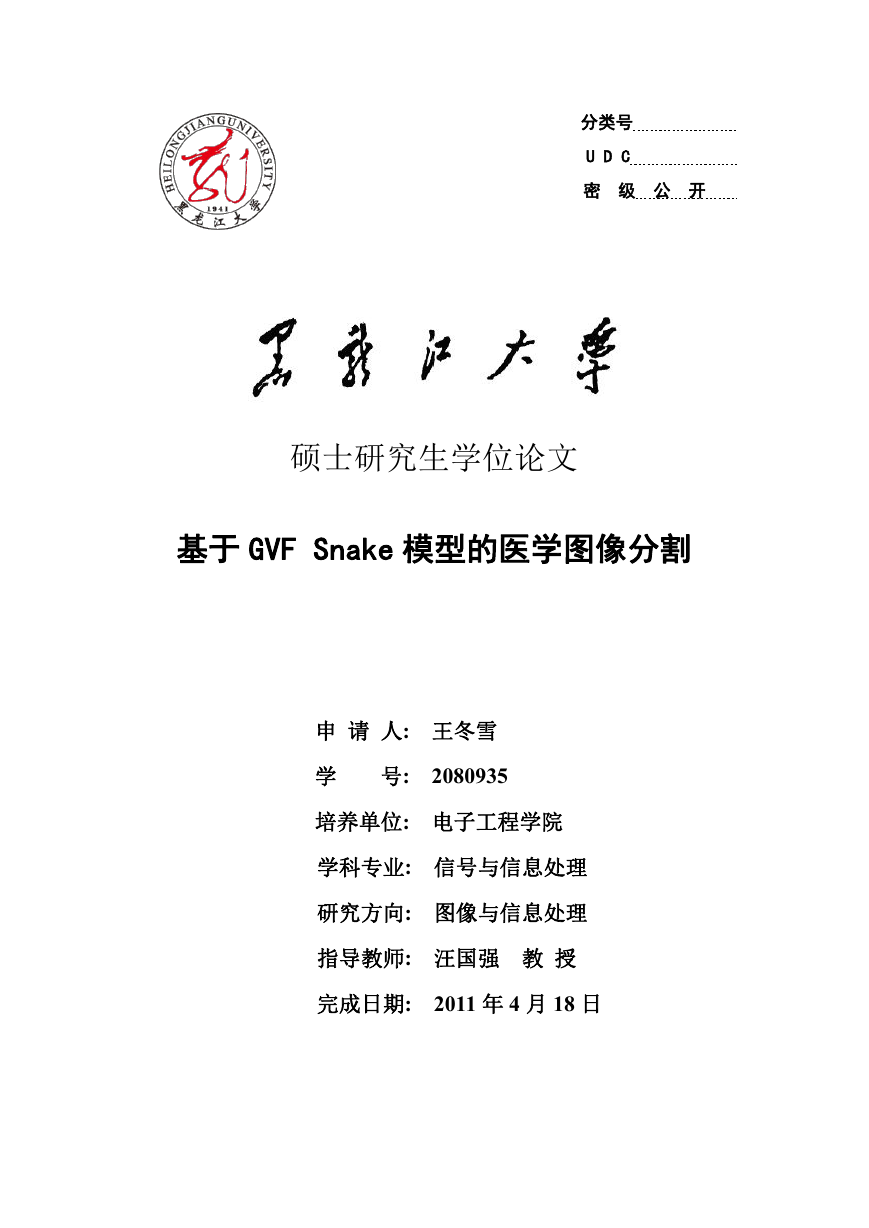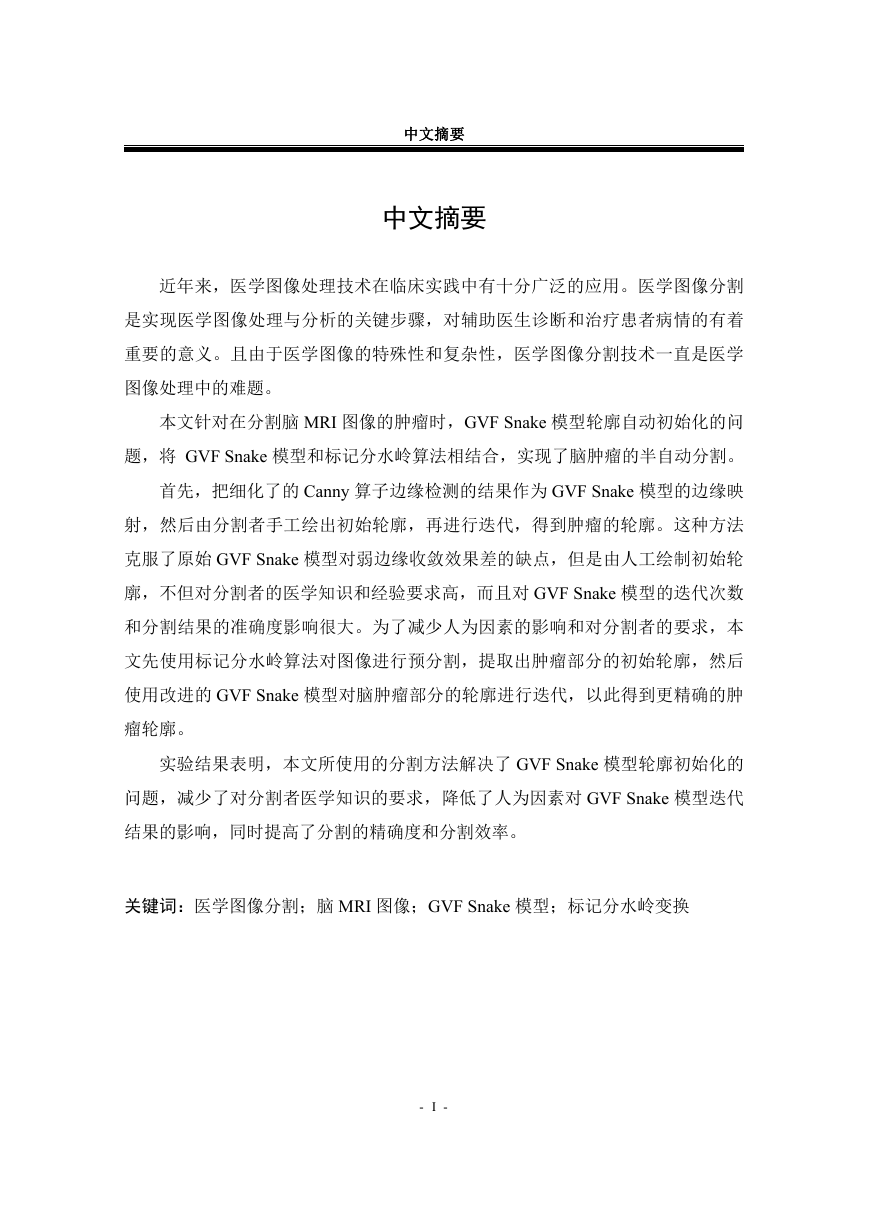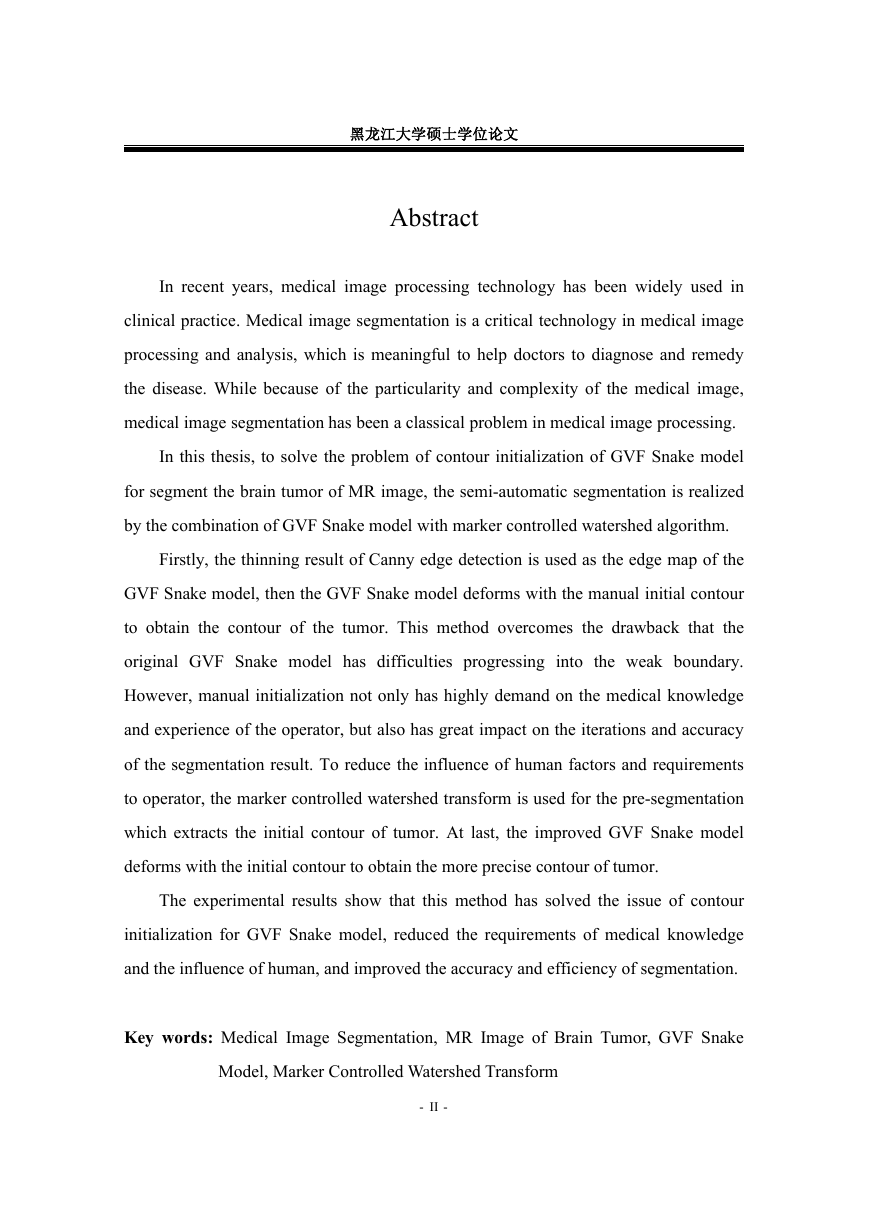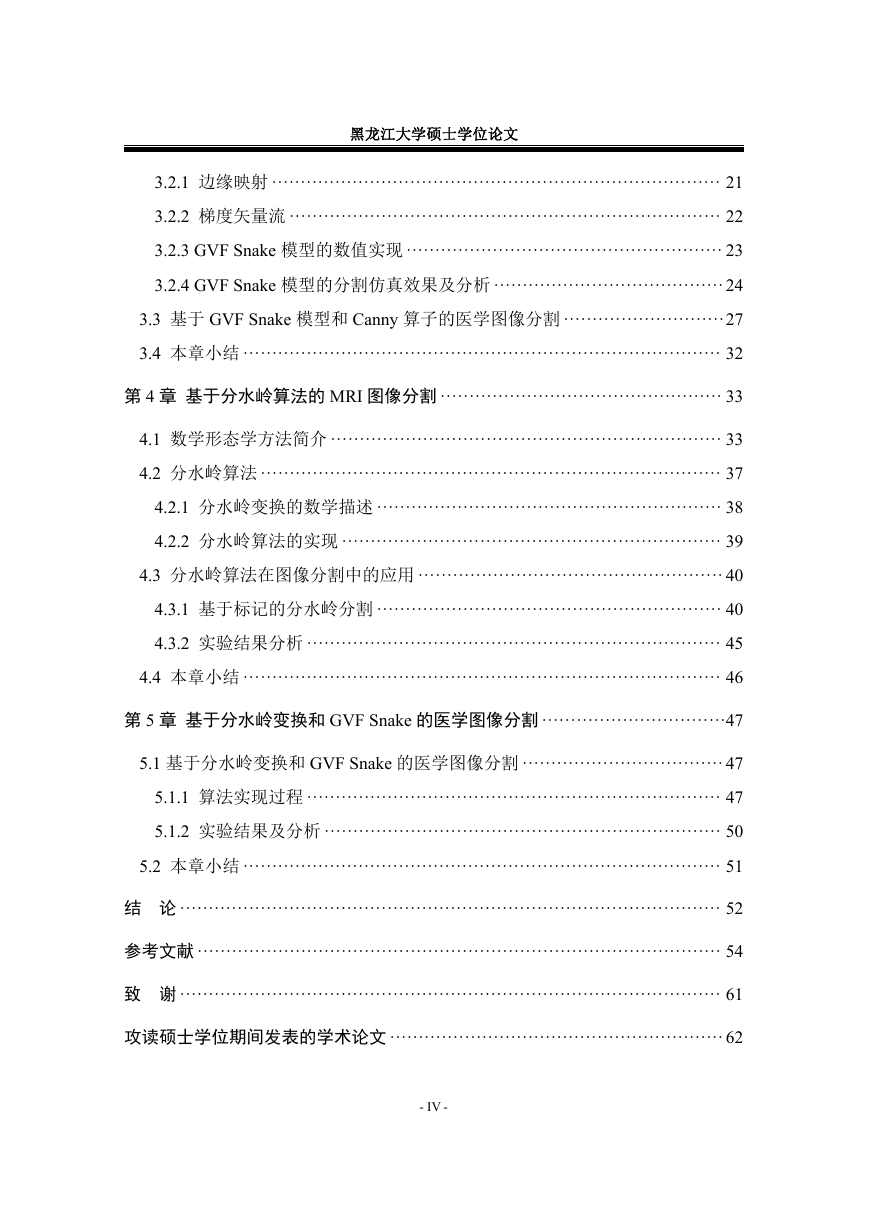分类号
U D C
密 级 公 开
硕士研究生学位论文
基于 GVF Snake 模型的医学图像分割
申 请 人: 王冬雪
学
号: 2080935
培养单位: 电子工程学院
学科专业: 信号与信息处理
研究方向: 图像与信息处理
指导教师: 汪国强 教 授
完成日期:
2011 年 4 月 18 日
�
�
中文摘要
中文摘要
近年来,医学图像处理技术在临床实践中有十分广泛的应用。医学图像分割
是实现医学图像处理与分析的关键步骤,对辅助医生诊断和治疗患者病情的有着
重要的意义。且由于医学图像的特殊性和复杂性,医学图像分割技术一直是医学
图像处理中的难题。
本文针对在分割脑 MRI 图像的肿瘤时,GVF Snake 模型轮廓自动初始化的问
题,将 GVF Snake 模型和标记分水岭算法相结合,实现了脑肿瘤的半自动分割。
首先,把细化了的 Canny 算子边缘检测的结果作为 GVF Snake 模型的边缘映
射,然后由分割者手工绘出初始轮廓,再进行迭代,得到肿瘤的轮廓。这种方法
克服了原始 GVF Snake 模型对弱边缘收敛效果差的缺点,但是由人工绘制初始轮
廓,不但对分割者的医学知识和经验要求高,而且对 GVF Snake 模型的迭代次数
和分割结果的准确度影响很大。为了减少人为因素的影响和对分割者的要求,本
文先使用标记分水岭算法对图像进行预分割,提取出肿瘤部分的初始轮廓,然后
使用改进的 GVF Snake 模型对脑肿瘤部分的轮廓进行迭代,以此得到更精确的肿
瘤轮廓。
实验结果表明,本文所使用的分割方法解决了 GVF Snake 模型轮廓初始化的
问题,减少了对分割者医学知识的要求,降低了人为因素对 GVF Snake 模型迭代
结果的影响,同时提高了分割的精确度和分割效率。
关键词:医学图像分割;脑 MRI 图像;GVF Snake 模型;标记分水岭变换
-
-I
�
黑龙江大学硕士学位论文
Abstract
In recent years, medical image processing technology has been widely used in
clinical practice. Medical image segmentation is a critical technology in medical image
processing and analysis, which is meaningful to help doctors to diagnose and remedy
the disease. While because of the particularity and complexity of the medical image,
medical image segmentation has been a classical problem in medical image processing.
In this thesis, to solve the problem of contour initialization of GVF Snake model
for segment the brain tumor of MR image, the semi-automatic segmentation is realized
by the combination of GVF Snake model with marker controlled watershed algorithm.
Firstly, the thinning result of Canny edge detection is used as the edge map of the
GVF Snake model, then the GVF Snake model deforms with the manual initial contour
to obtain the contour of the tumor. This method overcomes the drawback that the
original GVF Snake model has difficulties progressing into the weak boundary.
However, manual initialization not only has highly demand on the medical knowledge
and experience of the operator, but also has great impact on the iterations and accuracy
of the segmentation result. To reduce the influence of human factors and requirements
to operator, the marker controlled watershed transform is used for the pre-segmentation
which extracts the initial contour of tumor. At last, the improved GVF Snake model
deforms with the initial contour to obtain the more precise contour of tumor.
The experimental results show that this method has solved the issue of contour
initialization for GVF Snake model, reduced the requirements of medical knowledge
and the influence of human, and improved the accuracy and efficiency of segmentation.
Key words: Medical Image Segmentation, MR Image of Brain Tumor, GVF Snake
Model, Marker Controlled Watershed Transform
-
II
-
�
目 录
目 录
中文摘要 ····························································································· I
Abstract ······························································································ II
第 1 章 绪论 ························································································ 1
1.1 课题研究的背景和意义 ···································································1
1.2 活动轮廓模型国内外研究现状 ··························································2
1.3 论文的主要研究内容与组织结构 ·······················································5
1.3.1 主要研究内容 ··········································································5
1.3.2 组织结构 ················································································ 6
1.4 本章小结 ·····················································································6
第 2 章 医学图像分割概述 ······································································ 7
2.1 数字图像分割 ···············································································7
2.2 医学图像分割 ···············································································8
2.2.1 基于区域的分割方法 ·································································8
2.2.2 基于边缘的分割方法 ······························································· 10
2.2.3 其他分割方法 ········································································ 13
2.3 本章小结 ···················································································· 14
第 3 章 基于参数轮廓模型的医学图像分割 ··············································· 15
3.1 参数活动轮廓模型 ······································································· 15
3.1.1 Snake 模型的基本原理及数学模型 ···············································15
3.1.2 Snake 模型的数值实现 ······························································17
3.1.3 基于 Snake 模型的分割仿真效果及分析 ······································· 18
3.2 梯度矢量流模型 ·········································································· 21
-
III
-
�
黑龙江大学硕士学位论文
3.2.1 边缘映射 ·············································································· 21
3.2.2 梯度矢量流 ··········································································· 22
3.2.3 GVF Snake 模型的数值实现 ······················································· 23
3.2.4 GVF Snake 模型的分割仿真效果及分析 ········································24
3.3 基于 GVF Snake 模型和 Canny 算子的医学图像分割 ····························27
3.4 本章小结 ··················································································· 32
第 4 章 基于分水岭算法的 MRI 图像分割 ················································· 33
4.1 数学形态学方法简介 ···································································· 33
4.2 分水岭算法 ················································································ 37
4.2.1 分水岭变换的数学描述 ···························································· 38
4.2.2 分水岭算法的实现 ·································································· 39
4.3 分水岭算法在图像分割中的应用 ····················································· 40
4.3.1 基于标记的分水岭分割 ···························································· 40
4.3.2 实验结果分析 ········································································ 45
4.4 本章小结 ··················································································· 46
第 5 章 基于分水岭变换和 GVF Snake 的医学图像分割 ································47
5.1 基于分水岭变换和 GVF Snake 的医学图像分割 ··································· 47
5.1.1 算法实现过程 ········································································ 47
5.1.2 实验结果及分析 ····································································· 50
5.2 本章小结 ··················································································· 51
结 论 ······························································································ 52
参考文献 ··························································································· 54
致 谢 ······························································································ 61
攻读硕士学位期间发表的学术论文 ··························································62
-
IV
-
�
目 录
攻读硕士学位期间参加的科研项目 ··························································63
独创性声明 ························································································ 64
-
-V
�
�
















 2023年江西萍乡中考道德与法治真题及答案.doc
2023年江西萍乡中考道德与法治真题及答案.doc 2012年重庆南川中考生物真题及答案.doc
2012年重庆南川中考生物真题及答案.doc 2013年江西师范大学地理学综合及文艺理论基础考研真题.doc
2013年江西师范大学地理学综合及文艺理论基础考研真题.doc 2020年四川甘孜小升初语文真题及答案I卷.doc
2020年四川甘孜小升初语文真题及答案I卷.doc 2020年注册岩土工程师专业基础考试真题及答案.doc
2020年注册岩土工程师专业基础考试真题及答案.doc 2023-2024学年福建省厦门市九年级上学期数学月考试题及答案.doc
2023-2024学年福建省厦门市九年级上学期数学月考试题及答案.doc 2021-2022学年辽宁省沈阳市大东区九年级上学期语文期末试题及答案.doc
2021-2022学年辽宁省沈阳市大东区九年级上学期语文期末试题及答案.doc 2022-2023学年北京东城区初三第一学期物理期末试卷及答案.doc
2022-2023学年北京东城区初三第一学期物理期末试卷及答案.doc 2018上半年江西教师资格初中地理学科知识与教学能力真题及答案.doc
2018上半年江西教师资格初中地理学科知识与教学能力真题及答案.doc 2012年河北国家公务员申论考试真题及答案-省级.doc
2012年河北国家公务员申论考试真题及答案-省级.doc 2020-2021学年江苏省扬州市江都区邵樊片九年级上学期数学第一次质量检测试题及答案.doc
2020-2021学年江苏省扬州市江都区邵樊片九年级上学期数学第一次质量检测试题及答案.doc 2022下半年黑龙江教师资格证中学综合素质真题及答案.doc
2022下半年黑龙江教师资格证中学综合素质真题及答案.doc